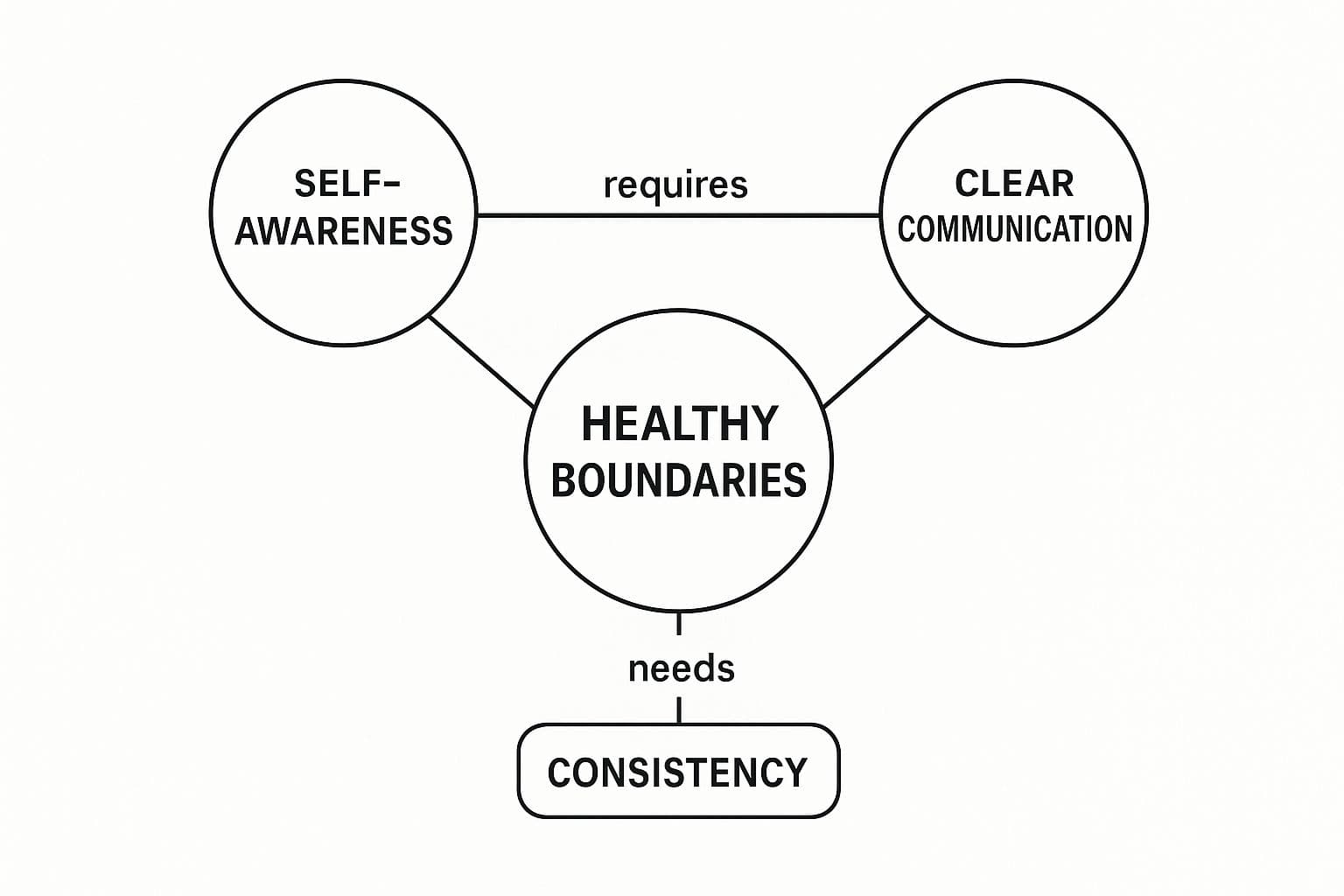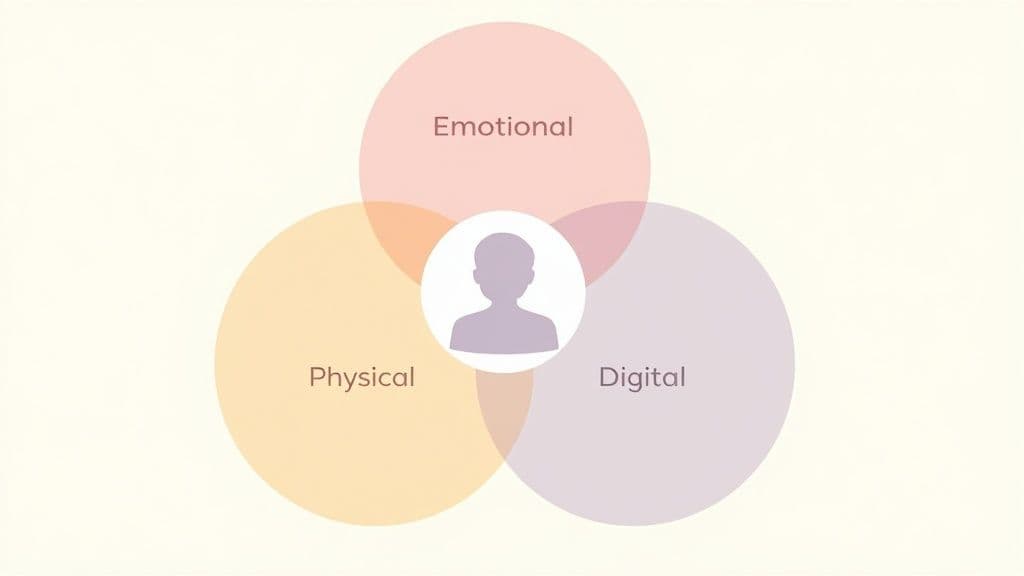Setting healthy boundaries begins with honest self-knowledge. Boundaries aren’t about building walls; they’re about creating the space you need to thrive. This article shows practical steps, scripts, and research-backed tips to protect your energy and improve your relationships.
August 14, 2025 (4mo ago) — last updated October 31, 2025 (1mo ago)
Set Healthy Boundaries for Better Relationships
Practical steps and scripts to set healthy personal and work boundaries, reduce burnout, and improve relationships with clarity and consistency.
← Back to blog
How to Set Healthy Boundaries: Tips for Better Relationships
Learn how to set healthy boundaries with practical steps, real-world scripts, and research-backed tips to protect your energy and improve your relationships.
Introduction
Setting healthy boundaries begins with honest self-knowledge. Boundaries aren’t about building walls; they’re about creating the space you need to thrive. This article walks through why boundaries matter, how to discover your limits, how to communicate them kindly but firmly, and how to hold them when they’re challenged.
Why Boundaries Are the Ultimate Form of Self-Care
Ever feel drained, resentful, or stretched too thin? Those are classic signs that your boundaries need attention. Think of your energy as a finite resource—every “yes” is a withdrawal. Without clear limits, you risk burnout, which the World Health Organization recognizes as an occupational phenomenon linked to chronic workplace stress1.
Setting boundaries is an act of self-respect. When you honor your limits, you protect your well-being and teach others how to treat you. Strong boundaries help relationships become more honest and sustainable rather than leaving resentment to build up.
Getting Past the Myths
| Common Myth | Reality |
|---|---|
| Boundaries are selfish and mean. | Boundaries are an act of self-respect that prevent resentment and improve relationships. |
| Setting a boundary will ruin the relationship. | Healthy relationships can withstand boundaries; often they become stronger and more honest. |
| Boundaries are punishment. | Boundaries protect your energy; they’re not tools to control others. |
| You must always justify your boundaries. | “No” can be a complete sentence; you don’t owe a long justification for protecting your well-being. |
The Three Pillars of Rock‑Solid Boundaries
Effective boundaries rest on three things: knowing yourself, communicating clearly, and staying consistent. Self-awareness informs what you need; clear communication expresses it without blame; consistency reinforces it so others learn it’s real.

If you want deeper insight into your patterns, tools like the Life Purpose App—based on Dan Millman’s The Life You Were Born to Live—can surface tendencies such as people‑pleasing or sensitivity to external pressure, which helps you know where to focus boundary work.
Boundaries aren’t static walls; they’re a dynamic practice. People’s boundary preferences and how they enact them change over time and with circumstance.
This is a journey of progress, not perfection.
Discovering Your Personal Boundary Blueprint

Before you set boundaries, identify where your energy is leaking. Track how you spend your time and how different interactions leave you feeling. Without that awareness, boundary changes are guesswork.
Practical Reflection: Identify Your Non‑Negotiables
Use a journal and answer these prompts honestly:
- At work: Which tasks drain me? When do I feel resentful? What’s my hard limit for answering emails after hours?
- With family: Which conversations exhaust me? Do I feel obligated to attend every event?
- In friendships: Which friends refill my cup and which deplete it? Who repeatedly ignores my hints?
- With myself: How much quiet time do I need? Am I protecting sleep and physical health? What are my limits for social media and news?
Situations that trigger resentment, anxiety, or exhaustion point to where boundaries are needed.
Life Path Insights (Optional)
Some people find it helpful to combine reflection with frameworks like the Life Purpose App, which links birth‑date patterns to tendencies that affect boundaries. Use such tools as insight, not excuse, to design boundaries that fit your temperament.
How to Talk About Your Boundaries Without a Fight
Communicating a boundary doesn’t require drama. The most effective tool is the “I” statement. Instead of blaming—“You always dump work on me”—try: “I need to keep my evenings free to recharge, so I can’t take on new tasks after 6 PM.” That centers your need and lowers defensiveness.
A Simple Three‑Part Script
- Start with your feeling or need: “I feel overwhelmed when…” or “I really need to…”
- State the boundary clearly: “…so I won’t be able to…” or “Moving forward, I’m not going to…”
- Offer an alternative if appropriate: “What I can do is…” or “Maybe we could try…”
Clarity reduces ambiguity and makes it easier for others to respond constructively5.
Real‑World Scripts
- For extra work: “I appreciate you thinking of me. My plate is full right now, and I need to protect my time to finish current projects well. I’ll have to pass on this.”
- For a loved one asking too much: “I love you, but I’m wiped out tonight and need quiet time. I can call tomorrow when I’m more present.”
- For a social invitation: “Thanks for inviting me! I can’t make it this time, but I hope you have a wonderful time.”
Keep it brief. You don’t owe long apologies or justifications.
Setting Boundaries in the Modern Workplace
The shift to remote and hybrid work has blurred lines between work and home, making clear boundaries more important than ever3. Constant connectivity can lead to burnout; protecting downtime helps you bring your best when you’re on the clock.

Defend Your Digital Downtime
- Put working hours in your email signature: “My hours are 9 AM–5 PM ET. I’ll respond during that window.”
- Use scheduled send for late‑night emails so you don’t create an expectation of immediate replies.
- Update statuses on Slack or Teams—“Focusing” or “Away” is a polite signal.
- Turn off work notifications after hours; silencing push alerts improves sleep and decreases stress4.
Protecting time is a professional strategy: teams that model clear boundaries support deeper work and reduce burnout. Employees with clear expectations and boundaries are more likely to stay and report higher satisfaction2.
Handling Scope Creep and After‑Hours Requests
When asked for “one quick thing” at night, reply calmly: “Thanks—I'm logged off for the day. I’ll make this my first priority in the morning.” That acknowledges the request while reinforcing your boundary.
What to Do When Your Boundaries Are Challenged
Expect pushback. People may react with guilt or resistance. Your best response is calm repetition. Restate your boundary without escalating the conflict; consistency teaches others it’s not negotiable.
Ways to Hold a Boundary Without Starting a Fight
- Broken Record: Calmly repeat your boundary: “As I said, I’m not available after 8 PM.”
- Create space: End a conversation or step away if someone repeatedly ignores your limits.
- Control your actions: Let calls go to voicemail or leave a room—you control your behavior.
The hardest part is tolerating your own discomfort about their reaction. Your feelings are valid, but they don’t mean your boundary is wrong.
Evolving Boundaries
Boundaries should change as your life changes. What you need during a high‑pressure project will differ from what you need during a quieter season. Check in with yourself periodically and adjust accordingly.
Common Questions About Setting Healthy Boundaries
What if I feel guilty after setting a boundary?
Guilt is common, especially for people who habitually put others first. Notice the feeling, remind yourself that setting a boundary is self‑respect, and practice small, consistent steps—the guilt fades with repetition.
How do I deal with someone who ignores my boundaries?
Be consistent. Restate the boundary, then enforce a consequence you control—end the call, leave the room, limit contact. Consistent actions teach people what your limits mean.
Can my boundaries change over time?
Yes. Boundaries are flexible and should be revisited as life circumstances shift. Regular check‑ins keep them aligned with your needs.
Quick Q&A
Q: Where should I start if I’ve never set boundaries before? A: Start small. Pick one easy boundary—like not answering work messages after dinner—and practice it for a week. Track how you feel.
Q: How do I say no without sounding harsh? A: Use an “I” statement, stay brief, and offer an alternative when appropriate: “I can’t tonight, but I’d love to meet next week.”
Q: When should I escalate a boundary issue? A: If someone repeatedly ignores your limits and it harms your well‑being, consider reducing contact, seeking mediation, or involving HR for workplace issues.
Ready to explore deeper insights into your personal patterns? The Life Purpose App, based on Dan Millman’s The Life You Were Born to Live, can help uncover tendencies that shape your boundary needs. Discover your core gifts and challenges at https://lifepurposeapp.com.
Discover Your Life Purpose Today!
Unlock your true potential and find your life’s purpose.
